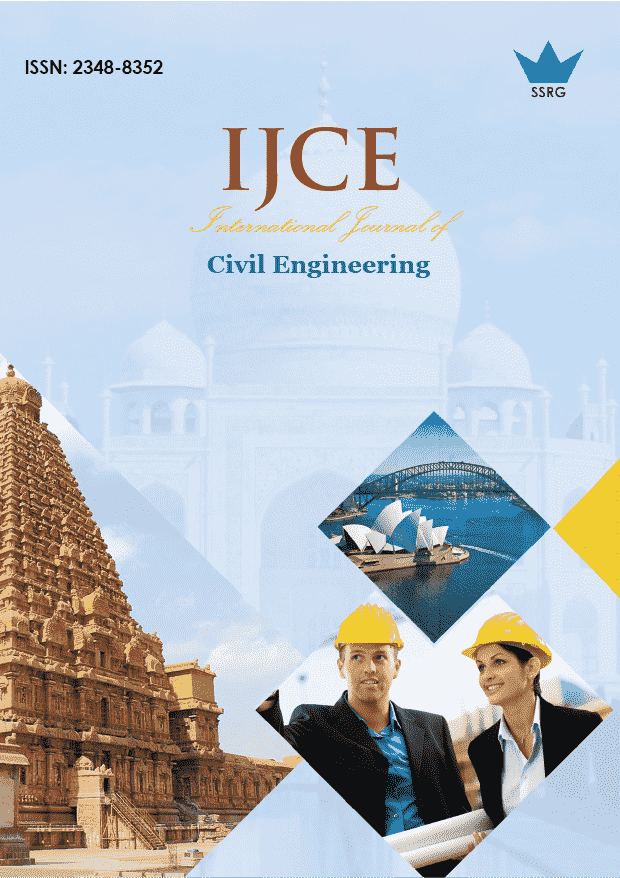Analysis of Informal Settlements in Risk Areas: Perspective of Sustainable and Resilient City

| International Journal of Civil Engineering |
| © 2025 by SSRG - IJCE Journal |
| Volume 12 Issue 10 |
| Year of Publication : 2025 |
| Authors : Tanya Veridiana Cueva Keanchong, Bryan Alfonso Colorado Pástor, Juan Carlos Briones Macias, Rommy Adelfa Torres del Salto |
How to Cite?
Tanya Veridiana Cueva Keanchong, Bryan Alfonso Colorado Pástor, Juan Carlos Briones Macias, Rommy Adelfa Torres del Salto, "Analysis of Informal Settlements in Risk Areas: Perspective of Sustainable and Resilient City," SSRG International Journal of Civil Engineering, vol. 12, no. 10, pp. 1-8, 2025. Crossref, https://doi.org/10.14445/23488352/IJCE-V12I10P101
Abstract:
Starting in the new century and between the time of transition from the sucre to the dollar in Ecuador (1999), a boom was generated in terms of the growth of informal settlements, especially in the Northeast and Northwest areas of Guayaquil because the land was much cheaper and in relationship without any legal owner, generating internal and external problems around risk in the territory. Therefore, by choosing the Coop, we want to demonstrate how urban environmental analysis can generate objective solutions for risk reduction in informal settlements. Sergio Toral Stage 1 as a case study. Among the methods used, the ethnographic and hermeneutical research design stands out for the development of strategies that protect these guidelines. The methodology is based on a qualitative and quantitative approach in relation to risk in the territory. In conclusion, it is obtained that the strategy generates a risk mitigation percentage of 52%, which meets the urban green index regulations, and that, through ODS guidelines, it would generate a risk reduction of 90% with the established actions.
Keywords:
Territorial risk, Sustainability, Informal settlements, Resilience.
References:
[1] Deborah L. Santavy et al., “A Biological Condition Gradient for Coral Reefs in the US Caribbean Territories: Part I. Coral Narrative Rules,” Ecological Indicators, vol. 138, pp. 1-13, 2022.
[CrossRef] [Google Scholar] [Publisher Link]
[2] Stefania Pareti Petruccelli, David Flores Escalona, and Loreto Rudolph, “Natural Resources as Promoters of Cultural Heritage, the Case of the Cáhuil Salt Flats, Chile,” Ge-Conservacion, vol. 23, no. 1, pp. 28-37, 2023
[CrossRef] [Google Scholar] [Publisher Link]
[3] Daniel S. Paredes et al., “The Multiscale Assessment of Infrastructure Vulnerability to River Floods in Andean Areas: A Case Study of the Chibunga River in the Parish of San Luis, Ecuador,” Sustainability, vol. 17, no. 17, pp. 1-26, 2025.
[CrossRef] [Google Scholar] [Publisher Link]
[4] Marta Borowska-Stefańska, “Conceptual Framework for Flood Vulnerability Assessment,” Natural Hazards Review, vol. 25, pp. 131-149, 2024.
[CrossRef] [Google Scholar] [Publisher Link]
[5] María José López, and Valeria Lucía Faginas, “Public Space as an Element of Territorial Cohesion,” Tourism and Society, vol. 25, pp. 131-149, 2019.
[CrossRef] [Google Scholar] [Publisher Link]
[6] María Lorena Sánchez Padilla, Jesús Rafael Hechavarría Hernández, and Yoenia Portilla Castell, “Systemic Analysis of the Territorial and Urban Planning of Guayaquil,” Proceedings of the AHFE 2021 Virtual Conferences on Human Factors in Software and Systems Engineering, Artificial Intelligence and Social Computing, and Energy, USA, pp. 411-417, 2021.
[CrossRef] [Google Scholar] [Publisher Link]
[7] Magdalena Wdowicka et al., “How to Create Healthy, Stress-Resilient Post-Pandemic Cities,” vol. 16, no. 9, pp. 1-23, 2024.
[CrossRef] [Google Scholar] [Publisher Link]
[8] María Milagros Fois et al., “Model for Urban Consolidation of Informal Human Settlements Based on Cooperation Systems and Human Participation in Guayaquil, Ecuador,” Proceedings of the 3rd International Conference on Intelligent Human Systems Integration (IHSI 2020): Integrating People and Intelligent Systems, Modena, Italy, pp. 1195-1200, 2020.
[CrossRef] [Google Scholar] [Publisher Link]
[9] Pawel Gromek, and Grzegorz Sobolewski, “Risk-Based Approach for Informing Sustainable Infrastructure Resilience Enhancement and Potential Resilience Implication in Terms of Emergency Service Perspective,” Sustainability, vol. 12, no. 11, pp. 1-30, 2020.
[CrossRef] [Google Scholar] [Publisher Link]
[10] Andrea Lauria, Green Spaces and Public Health in Urban Contexts, Therapeutic Landscape Design Methods, Design Strategies and New Scientific Approaches, pp. 93-99, 2023.
[CrossRef] [Google Scholar] [Publisher Link]
[11] Antonio Cicione et al., “A Preliminary Investigation to Develop a Semi-Probabilistic Model of Informal Settlement Fire Spread using B-RISK,” Fire Safety Journal, vol. 120, 2021.
[CrossRef] [Google Scholar] [Publisher Link]
[12] Sotiris Vardoulakis et al., “Urban Environmental Health Interventions towards the Sustainable Development Goals,” Science of the Total Environment, vol. 748, pp. 1-4, 2020.
[CrossRef] [Google Scholar] [Publisher Link]
[13] Hengrui Chen et al., “Static and Dynamic Resilience Assessment for Sustainable Urban Transportation Systems: A Case Study of Xi 'an, China,” Journal of Cleaner Production, vol. 368, 2022.
[CrossRef] [Google Scholar] [Publisher Link]
[14] Junhang Liu et al., “Suitability Assessment of Small Dams’ Location as Nature-Based Solutions to Reduce Flood Risk in Mataniko Catchment, Honiara, Solomon Islands,” Sustainability, vol. 15, no. 4, pp. 1-20, 2023.
[CrossRef] [Google Scholar] [Publisher Link]
[15] Diana Vallejo-Robalino, Ingrid Ríos-Rivera, and Gabriela González Plaza., “Social Cartographies in Contexts of Violence (s):(Re) Mapping Borders and Limits in the Peripheral Barrios of Guayaquil, Ecuador, Journal of Social Studies, 2024.
[Google Scholar] [Publisher Link]
[16] Andrea Perez Lopez, Maikel Leyva Vazquez, and Jesús Rafael Hechavarría Hernández, “Pedestrian Traffic Planning with TOPSIS: Case Study Urdesa Norte, Guayaquil, Ecuador,” Proceedings of the 3rd International Conference on Human Interaction and Emerging Technologies: Future Applications, Paris, France, pp. 69-76, 2021.
[CrossRef] [Google Scholar] [Publisher Link]
[17] Luis Carlos Correa-Ortiz, Catalina Guevara-Giraldo, and Elizabeth Chaparro Cañola, “Manizales, Smart and Sustainable Tourist Destination,” Trends in Sustainable Smart Cities and Territories, pp. 62-74, 2023.
[CrossRef] [Google Scholar] [Publisher Link]
[18] Carlos Zeballos-Velarde, and Sheyla Chevarria-Aredo, “Place Building: Enhancing resilience in Hazard-Prone Public Areas. The case of Arequipa, Peru,” ZEMCH International Conference, pp. 20-34, 2023.
[Publisher Link]
[19] Arash Lotfipour, and Seyed Saeid Mohtavipour, “A Multi-Criteria Decision-Making Model to Determine the Optimal Share of Variable Renewable Energy Sources in a Wholesale Electricity Market,” Sustainable Energy, Grids and Networks, vol. 39, 2024.
[CrossRef] [Google Scholar] [Publisher Link]
[20] Marcello Magoni, and Rachele Radaelli, “Toward a Shared Glossary for Territorial Risk Management Due to Climate Change,” Italian Journal of Planning Practice, vol. 11, no. 1, pp. 42-60, 2021.
[Google Scholar] [Publisher Link]
[21] Maria Camila Suarez-Paba, and Ana Maria Cruz, “A Paradigm Shift in Natech Risk Management: Development of a Rating System Framework for Evaluating the Performance of Industry,” Journal of Loss Prevention in the Process Industries, vol. 74, 2022.
[CrossRef] [Google Scholar] [Publisher Link]
[22] S.A. Chupikova, and T.M. Oydup, “Challenges in Development of Reclamation Areas in the Republic of Tyva (Geoinformation Aspect),” Russian Mining Industry, no. 1, pp. 132-137, 2024.
[CrossRef] [Publisher Link]
[23] Anass Malah et al., “Territorial Sustainability Performance Assessment in African Context: Case Study of the Moroccan Provinces,” Journal of Cleaner Production, vol. 433, 2023.
[CrossRef] [Google Scholar] [Publisher Link]

 10.14445/23488352/IJCE-V12I10P101
10.14445/23488352/IJCE-V12I10P101